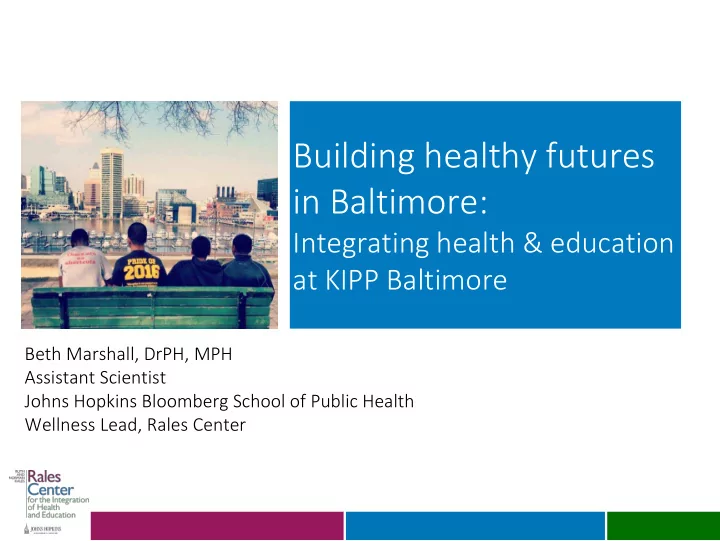

Building healthy futures in Baltimore: Integrating health & education at KIPP Baltimore Beth Marshall, DrPH, MPH Assistant Scientist Johns Hopkins Bloomberg School of Public Health Wellness Lead, Rales Center
Educational Outcomes Health Outcomes
Health h Educational Dispa parities Dispa parities Stress Poverty Trauma Stress Poverty Trauma Nutrition Nutrition No Access to Care School climate Education Teacher/curriculum Quality Health Behaviors Health & Health Behaviors Poor Housing Poor Housing Toxins Toxins Inequities Inequities Adapte ted f from om: Ito Iton, A A. Ca California ia En Endowment
The Rales Center’s vision is to be a national leader in developing, evaluating, and disseminating new school- based models that integrate health, educational, and developmental services for young people and their families.
K-4 th 5 th -8 th 848 789 students students
KIPP Student demographics • 99% African American • More likely to live in socioeconomically disadvantaged communities • 70-80% economically disadvantaged Neighborhood poverty levels, KIPP Baltimore students.
Our enhanced Nurse school health Pediatrician Practitioner staffing model ONE School allows us to take a Nurse Nurses Family Practitioner population health Advocate approach to Parent comprehensive Engagement Medical school health and Assistant Wellness wellness.
Innovative Treatment of Chronic Conditions
Evaluation Goals 1. Characterize baseline health needs and resources 2. Track the process of implementation 3. Evaluate impact and cost effectiveness
So, how are we doing? Pediatric care Wellness curriculum Teacher wellness
53% of students failed vision screening, a rate higher than the national average
More than one third of students are overweight or obese 42%
Asthma and ADHD prevalence among KIPP’s 1517 students 25% of students with asthma 8% of students with ADHD
Evaluation Goals 1. Characterize baseline health needs and resources 2. Track the process of implementation
The Rales Health 77 77% Center has among the highest School Based Health Center enrollment rates in Maryland.
In the first three years of the program, there were: 54k visits to our school nurses. 3,955 visits to our pediatrician and nurse practitioner. 109 families connected with our family advocate .
93% of KIPP students participated in at least one school-wide screening program for asthma, dental hygiene, fitness/obesity, or vision. That’s 8,505 screenings!
547 students participated in vision screening at school, last year. Students who failed received in-school optometric exams pairs of eyeglasses were provided in-school
Brain Breaks! In one year, more than 458K student minutes of physical activity were brought into classroom activities to get kids moving
Evaluation Goals 1. Characterize baseline health needs and resources 2. Track the process of implementation 3. Evaluate impact and cost effectiveness
Having a health center at KIPP prevented 212 emergency room visits in the first three years of the program 21 212
Between years 1 & 3 … Chronic absenteeism dropped by 49% among students with asthma Chronic absenteeism dropped by 50% among students with ADHD
Despite higher staffing costs, every $1.00 invested in the Rales Health Center returns more than $4.20 of social benefit
+ Rales Team Parent Wellness Engagement Administration & Evaluation
Recommend
More recommend